Living in New England means that about 1/4 of your running year is in colder weather. Because of this it is very important to know how to dress for running in cold weather. Although the average temperatures will dip to the low 30s, there are many days with temps in single digits and teens. Add in wind chills and you better be ready to take on the elements.
This also means more cold running sessions in snow and ice covered routes. Your running mindset needs to be adjusted for these types of runs. Luckily it is largely a case of mind over matter; as long as you are properly prepared. There is no substitute for good preparation and proper running clothes and gear.
Of course a little common sense never hurts either. A standard set of running rules that our group follows is no runs if the temps creep above 90 degrees in the summer or less than 10 degrees in the winter. Follow some sound advice on Safety Tips for Exercising Outside from The Mayo Clinic

Don’t forget to warm-up
Warm ups are always important before exercise but take on added importance in cold weather running preparations. If warm-ups are skipped, it can lead to uncomfortable runs that too often display very poor form, possibly leading to injury.
Standard running warm-ups should include at least sets of lunges, jumping jacks, knee kicks, and butt kicks to name a few. There are many differing opinions on stretching prior to runs in any weather. It’s generally accepted to not stretch pre-run as your body and muscles are cold, not yet warmed up and therefore prone to injury.
If you do choose to stretch, please take it slow and easy. The main goal of warming up pre-run is to get your heart rate moving, and your body jump started for what’s coming next.
Advice: How To Dress For Running In Cold Weather
Rule #1: common sense applies here. A general rule of thumb for cold weather runners is to dress as if the temperature are 10-15 degrees warmer than it actually is. This accounts for the body heat you will generate through exercise as you begin your run.
This may be tough to get used to when you begin. You’re cold when you start; it doesn’t make sense. The first time you fall into the trap, and put on that warmer clothing, you will know. You’ll get hot too soon, probably sweat through your base layer(s) and then be cold as that sweat cools down on your skin.
Dressing in layers is the most simple of ideas. Depending on the weather, you should start with a base layer and finish with a shell layer, with as many layers as necessary between the two. If you find the weather warming, or your are overdressed you can then easily begin peeling layers until comfortable.
Wicking materials provide comfort and transport sweat away from body, through the wicking layer, settling on the outer layers. Figure out what works for you and then slowly fill out your inventory as needed. It will lead to many successful and enjoyable runs – and much less weather related excuses!!!
What To Wear On Your Upper Body During Winter Runs
Covering your upper body for weather related runs is most complicated simply due to the number of options available to you. Through trial and error you can easily settle into your perfect combination of proper clothing to wear on winter runs.
We start with a base upper layer, usually made from a polyester blend material that keeps you comfortable. This base as will draw moisture away from your skin as you run. Short or long sleeve options are available and some long sleeves have thumb slots and hoodies.
Fleece layers and comfort warmth layers consist of full zip and pullover options as well as vests. Fleece can provide both warmth and insulation with varying grades of thickness for any of your needs. This layer is usually just one layer between your base and your shell, but can be more for really cold runs.
A jacket or a shell layer rounds out your upper body running wardrobe. This layer can vary greatly to align with your weather related needs. For example 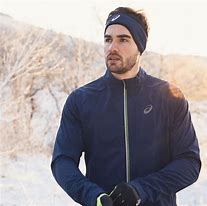 one on occasion you may need just a thin layered shell which is windproof for say an early fall run.
one on occasion you may need just a thin layered shell which is windproof for say an early fall run.
Another time you may also need a thin layer, but with waterproof material to protect you from the elements. As the season progresses you will also get into the heavier, warmer jacket layers to provide needed warmth. Today’s technology can nicely combine these various levels of thermal warmth while still allowing for breathability throughout.
What To Wear On Your Lower Body During Winter Runs
The majority of key running muscles obviously are in our lower body and 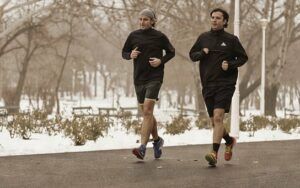 legs. Therefore, it is very important to keep these regions warm, limber and loose. The main options here are basic.
legs. Therefore, it is very important to keep these regions warm, limber and loose. The main options here are basic.
Tights and leggings are musts for lighter coverage in late fall and early winter. Some folks prefer to run in these throughout the winter. Another option in cool but not cold weather are my favorites, lightweight polyester sweats with a tapered leg which are snug fitting and comfortable.
Colder weather solutions are numerous and varied. For extreme cold there are more heavy-duty sweats, which are thermal or insulated. These can also be found in windproof and waterproof options.
When my training turns from fall to winter, I’ll go as long as I can with a lighter sweatsuit pant. When these become too light I will follow the layering model above and wear light leggings under my lighter sweatpants. And, finally, if an arctic blast sets in, I’ll combine both. There’s no way around a race day weather forecast which is 10 degrees and wind chill added in. With the right clothing solutions, you don’t need one.
Other? Not A Chance…
I hate to list anything under a heading labeled “Other”, especially something as important as this list. Running tops and bottoms cover most of our bodies during cold weather running. These other products are what really make your cold weather running experiences comfortable and enjoyable – or not.
Headgear – This category consists of hats and headbands, there are plenty, 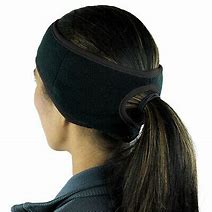 find what fits, what covers and what works for you. Also in this category, don’t forget your cowl or neck warmer. These can range widely in materials from polys to fleece for whatever level of cold you’re in. These are also great in really cold weather as they pull up onto the bridge of your nose for those windy days too.
find what fits, what covers and what works for you. Also in this category, don’t forget your cowl or neck warmer. These can range widely in materials from polys to fleece for whatever level of cold you’re in. These are also great in really cold weather as they pull up onto the bridge of your nose for those windy days too.
Gloves – goes hand in hand [:-)] with your headgear. There are different grades of gloves and, like pants, can be layered if needed when it’s really cold. Lightweight knit gloves are good for those cooler but not cold runs. Heavier grade poly knit and thermal gloves work for when it gets really cold. Many now come with touch pads on the index finger as well so you can operate your cell phones without taking them off.
Below The Neck
Undergarments – And now for this sensitive subject – in more ways than one! In extremely cold weather you want to keep everything warm!!! Luckily for all, there has been updated options for this category in both mens and womens undergarments including the latest and greatest addition to cold weather running apparel – “runderwear”. No Kidding! You only need to get caught once and you’ll realize how important this category is.
Gaiters are a great way to keep exposed lower legs and ankles covered on very windy or snowy days. These are also very useful in wetter conditions to 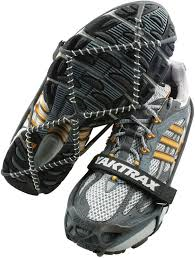 keep snow and ice out of your running shoes. Sometimes we have no choice. If you’re doing winter training for a spring marathon, or are simply just hardcore, you may have no choice but to run on ice covered routes.
keep snow and ice out of your running shoes. Sometimes we have no choice. If you’re doing winter training for a spring marathon, or are simply just hardcore, you may have no choice but to run on ice covered routes.
Ice snow grips like Yaktrax are essential and provide necessary traction and piece of mind on those slippery days. Personally, I’m not a fan of these as I don’t like the gripping texture that they provide but I know others who swear by them. Like many things in this great sport YMMV (your mileage may vary!!!)
Shorter days means morning and afternoon running is probably done in some 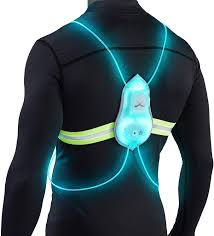 level of darkness. Reflectors and body lights are a must for your safety. There are a wide range of gear options to help with reflection. Some of the most basic consist of reflection on your shoes, reflective vests, belts, hats and arm bands.
level of darkness. Reflectors and body lights are a must for your safety. There are a wide range of gear options to help with reflection. Some of the most basic consist of reflection on your shoes, reflective vests, belts, hats and arm bands.
Another great option are the illuminated and reflective packs or vests that they have which reflect bright neon colors. These illumination packs often have LED optic packs which make you visible from quite a distance.
Running shoes for winter running are also very important and integral part of your body armor against the elements. Be sure to check out our advice on choosing the best road running shoes choices here.
What Do You Think?
Well there you have it. Dress up, dress right, run, finish and cool down quickly. Some key points to be sure you address AFTER your run. Be sure to cover up quickly and get out of the elements if they are extreme. Peel off your layers, and if still milling around after your run, at a race or such add newer and dry layers – sweatshirts and fleece.
CHANGE YOUR SOCKS and SHOES. It’s amazing, even in cold weather, how much our feet sweat. Be sure to replace socks with a dry pair and warm shoes as well. Stretch it out, take the time to cool down and stretch out as needed to keep your body right. Any warm fluids available? They are a great way to get your body and temperature back to normal, so do what works for you.
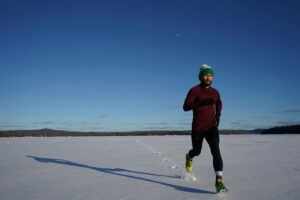
That’s it from us. Our little bit of information on how to dress for running in cold weather. We hope that our info on cold weather running has helped you and given you some ideas to help you get out there and run. What are your preferences and secret tips? Care to add any ideas or have comments on anything we’ve covered above? The better info we share, the more training we can do, and the more we can help our running friends.
Please drop me a note or reply below. I’d love to hear from you and discuss whatever you can think of. I’ll be sure to respond and keep the dialog rolling.
Best of luck with your running and training, be safe out there and as always…
Carpe Viam (Seize the Road!!!)!!!

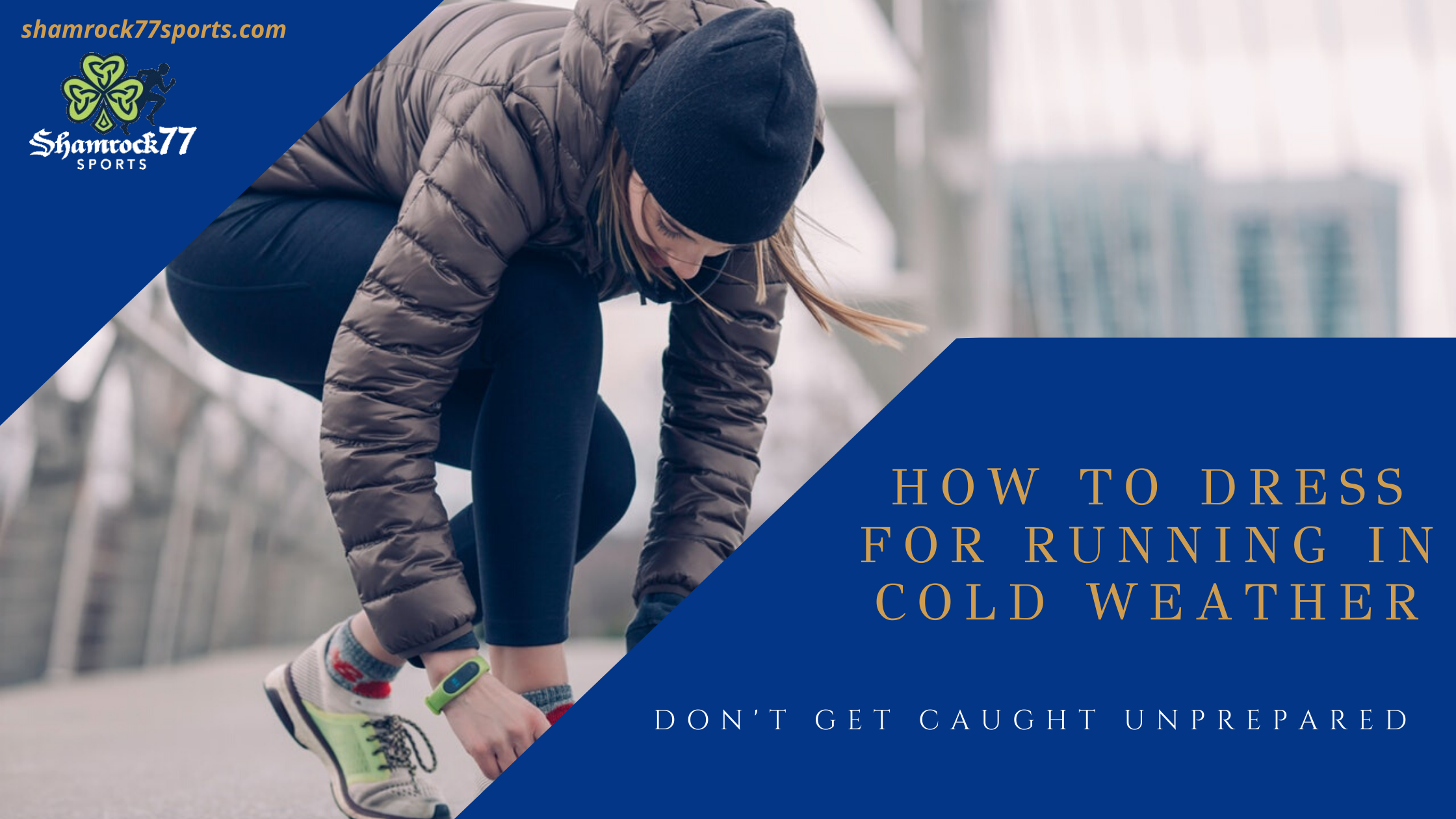

Very happy to have come across this running site. I am an active runner in Northern NB (Canadian Maritime Provinces) and was happy to read this article on Winter running, which we have 7 months of in our region. I would suggest linking some of your images to affiliate program sites. For example, the photo of the gentleman with the ear muffs is a product that I would gladly buy as I despise running in a tuque.
Apart from the monetizing aspect, your website appears very professional, is well packaged, and easily navigated. I’ve even gleaned the idea of an Info drop-down menu to use on my own website.
Continued success!
Hi Justin,
Thanks for stopping by and for the note. We do have added challenges as winter runners, but I’ve had some of my absolute best experiences in the winter months. Thanks also for the suggestions for site improvements. We are in the process of upgrading and will surely be adding some links to allow our readers to purchase some of these great products if they’d like to. Be sure to check back again soon and see the new look. I’m sure your ear muff category will be a great addition to these many great options.
Thanks again!!!
Very thorough! Definitely something I need to take into consideration as a Canadian runner!
Thanks, Laura Jane, for visiting. Be sure to check in again as we’ll have plenty more gear and gadgets info coming soon, many of which can be used in the Great White North.
Hi Kerry. Thanks for a very thorough and interesting article on keeping safe and comfortable when running in cold winter conditions. As I live in “Old England”, its not that often I have to deal with sub-zero temperatures, but when they do happen, and if I travel to colder climes during winter, I will be following your advice, which makes lots of sense.
Thanks John!! Good luck with your running and training. Be sure to check back again in the future as we build out more info to help you meet your goals.
Carpe Viam!!!(Seize the Road!!)
Kerry
Carpe Viam- I love that! Gosh, I tip my hat to you being able to run in cold temperatures like that- amazing! It’s so great that you talk about what can help with running on ice, it’s icy here at the moment and when I was walking the dog earlier even if my trainers I kept skidding. So it’s great to know there’s something that can help runners be able to keep training through most weathers.
I’m definitely going remember what you said about layers as well, as I think that applies to dancing too.
Hi Natalie, Thanks for visiting!! I’m glad you found some info that you’ve found useful. Please be sure to come check us out again for more helpful hints and by all means, let us know how the layering affect works in the dancing world as well.
Best Regards,
Kerry
Hey Kerry! What a great article! We’re lucky down in NC to have fairly mild winters but it does get cold! My boyfriend is a runner and will appreciate the gear rundown. Thanks!
Hi Katie,
I’m glad you liked the article. New Englanders are often jealous of your winter weather down South, especially when we have a Canadian Clipper blowing through. Many of the topics listed in the article are also good solutions for late fall and early spring running. Thanks for sharing your thoughts,
Kerry
Hi Kerry, thanks for the article! Being Canadian but living in the UK I don’t often get the opportunity to run in the snow, ice and colder weather anymore, so I’m filing this away for when I’m packing for my next trip home!
I find here that I really struggle with the temperature just around freezing, but raining (which happens a lot), the thermal and waterproof matching for that temperature is a knack that I haven’t managed to get right. I imagine you’ve had to undertake a lot of trial and error to get even more complex conditions right for you.
Do you have any experience with technical solutions to visibility in the dark winter nights? I’m seeing a lot of people with lighting contained within their jackets and I was wondering if that prevents the mile after mile off balance or banging effect of poorly fitting light solutions (for instance, I have a tiny head and can’t find a headlight that fits without ending up in my eyes or off center).
Thanks again!
Hi Lisa,
Thanks for visiting and your questions. Great point about those ‘tweener’ days where it’s cold and rainy/snowy. On such runs I usually opt for warmth over dryness if that’s possible. Although a bit of my gear is waterproof(somewhat), I always still seem to get wet somehow, so if I can at least keep warm, I feel like I have control over something.
For running in darkness we use these great reflective vest/belts which can be seen from quite a distance and works well for us, even in our rural setting. I don’t personally use those powerpack lights but know others who do and love them. My wife uses the headlamps and like them, they do fit well over her hat which helps. Be sure to come back and check out our site again, we’ve added a topic for night running lighting reviews to our list and will be publishing it in the near future.
Best of Luck,
Kerry
Excellent post…running in the elements especially in the colder weather climates is not for the faint of heart. Almost makes me want to get out there and have a go…almost….it’s 25 degrees and snowing…maybe one read one more blog post….
HaHa, Thanks for visiting Bob. Glad you enjoyed the article. Warmer weather is coming, you’ll be out there in no time but rest assured, running in the cold is doable and survivable!!!
Best Regards,
Kerry